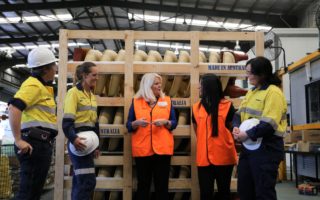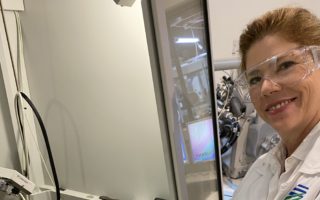Leading women in Australian manufacturing ‘choose to challenge’ views about STEM careers this International Women’s Day
Australian manufacturing is transforming and is today one of the nation’s most dynamic industries. Yet, one metric proves that Australia is not taking full advantage of the industry’s potential – that is its low female participation.
According to research conducted by Advanced Manufacturing Growth Centre (AMGC), one of the key factors contributing to low participation of females in Science, Technology, Maths and Engineering (STEM) is a lack of representation of female leads in STEM and understand all the exciting opportunities manufacturing has to offer.
These findings are echoed in a federal government body of research and policy publication titled: Advancing Women in STEM strategy championed by Engineer and Federal Minister for Industry, Science and Technology, the Honourable Karen Andrew MP.
“I am passionate about seeing more women taking on STEM careers and working in manufacturing. Increasing women’s participation in STEM is not only important for women – it is vital for strengthening our economy and creating the jobs we need for the future,” said Minister Andrews.
Managing Director for AMGC, Dr Jens Goennemann couldn’t agree more, “With the theme of International Women’s Day being ‘Choose to Challenge’, AMGC would like to celebrate a number of leading women who challenge the myth that a career choice in manufacturing, or any STEM-related discipline, isn’t for women. Australian manufacturing is the engine room of advancement, underpinning our moves from a lucky country to a smart country and women must play a bigger role,” said Dr Goennemann.
Dr Kymberly Talbot, Managing Director of Gold Coast based lithium-ion battery developer FELINE. Jens explains: “[Students should] understand that STEM disciplines are tools that teach you about many things, not just the technical stuff, but also how to analyse a situation – a way of thinking if you like.
“The adaptability of STEM is significant in these days of changing career opportunities and challenges. These tools are transportable to most aspects of your life, like career changes, travel, banking, and shopping – yes shopping requires analysis when costs are high. I have a black belt in shopping,” said Dr Talbot.
Further research conducted as part of AMGC’s 10 Ways to succeed in Australian manufacturing report, involved focus groups of over 1000 students across the nation in which students were presented with information about what today’s manufacturing looks like.
Far from the outdated images of blue overalls and dark sheds, manufacturing today is as diverse as the population of Australia covering every sector of the economy where something is being made. The information provided to all participants resulted in a 47% net increase in interest as a manufacturing career.
Women, in particular, said that having a better understanding of the industry’s opportunities and seeing themselves included in communications about manufacturing had a strong impact on their ‘mental availability’ to choosing manufacturing as a career path.
This is a point reinforced by Dr Heba Khamis, CEO of Contactile a cutting-edge Sydney based biomedical company specialising in bestowing robots with the sense of touch and human-like dexterity.
“Women remain underrepresented across all STEM studies and careers – but that shouldn’t discourage you! The only thing that is going to stop you from pursuing a career in STEM is you – if you want it, you can have it!
“A career in STEM is an opportunity to be on the cutting edge and work with the latest technology, these careers are the fastest-growing in the world, with high demand, high pay and a high level of job satisfaction.” said Dr Khamis.
Employing over 1.27 million Australians, modern manufacturing has evolved to encompass seven distinct steps along the manufacturing “smiley-curve’ or value chain. These steps encompass roles in research and development, design, logistics, production, sales (including marketing and communications), service and support, and as such support a vast array of career options for prospective students in disciplines that are higher paid and more resilient that those that went before them.
Dr Priscilla Rogers, a serial entrepreneur and industry disruptor, who currently works in tandem with her husband is reinventing the way vehicles interact with the road via their Victorian company DOFTEK, explains “It was during my Bachelor of Engineering degree at Monash University that I discovered that there were almost endless career possibilities in the fields of STEM.
“My advice to young females considering a career in STEM is to realise that you can take your career in any direction you like. Problem solving, critical thinking and analytical reasoning are highly desired across many industries,” said Dr Rogers.
For these Australian industry leaders, consideration of a career in STEM was a natural progression, while others stumbled into it.
Dr Heba Khamis: “I have always enjoyed making things and have always been curious about how things work – even as a child, I was building things with Lego, I wanted my own Meccano set, and I liked to play with JayCar electronics kits.”
Dr Kymberly Talbot: “I went to a school careers day when I was about 16, which got me thinking a lot. Initially, I thought about the fit between my liking to cook and wanting to build a career for myself that paid well and gave me options. I guess I am passionate about both. For me, my current role in advanced manufacturing is a bolt-on of mechanical and chemical engineering (which helped my cooking) rolled into one.”
Dr Priscilla Rogers: “My interest in science and maths heightened during my high school years. I took comfort in the exacting nature of all my STEM subjects and appreciated that with enough learning and time, I could achieve a “right” answer. This suited my personality well as I have always been focussed on achieving perfection.”
While AMGC data suggests that a lack of visible female STEM leaders impacts consideration of the career path for students, these leaders inspiration to enter a STEM career came from a variety of sources and in some instances gave them a distinct advantage.
Dr Heba Khamis: “My dad encouraged me to combine the medical science degree with an engineering degree in case the medical pathway didn’t work out. It was an excellent move for me! I loved the engineering degree and having the medical science background under my belt enabled me to work in biomedical engineering research – once again combining a love for solving problems and a passion for health.”
Dr Kymberly Talbot: “My idols were the same as anyone else’s, but hands down, my current advanced manufacturing idol is Elon Musk. I was fortunate enough to see the Tesla Gigafactory in its early days. Then, it was a self-described technology-based start-up – on steroids! Talk about a rocket ride!”
Dr Priscilla Rogers: “My advice is to use your perspective as a female to your advantage. Females have an enormous capacity to excel in technical fields. With strong skills in empathy and social and emotional intelligence, females make strong team players and project leaders, and are excellent at listening to customer needs.”
And the final words, from the team of Australian Manufacturing leaders to anyone considering a career in the fields of Science, Technology, Engineering and Maths are:
Hon Karen Andrews MP: “Myself and another Karen were the first women to graduate with a mechanical engineering degree from QUT. But today, things are different – girls and women are now taking their rightful place in all sorts of university courses and professions and I want to see more of it.”
Dr Heba Khamis: “Why not consider a career in STEM?”
Dr Kymberly Talbot: “Be the mistress of your own destiny”
Dr Priscilla Rogers: “I am a big believer that passion and success are closely aligned. I would recommend that students think of moments when they are really happy and find a career that aligns with that.”
To learn more about how Australian manufacturing is changing and the people driving the change, students, teachers, professionals and parents are encouraged to visit AMGC’s free Manufacturing Academy to hear from leaders from across the manufacturing industry.



